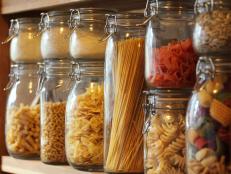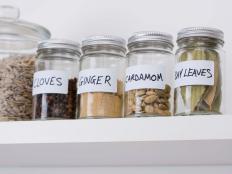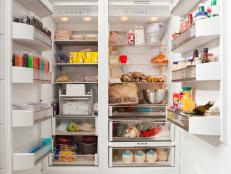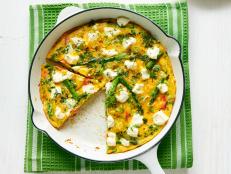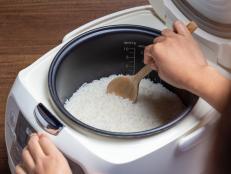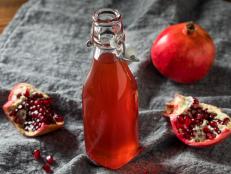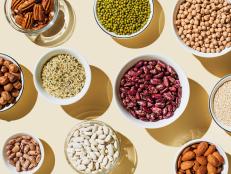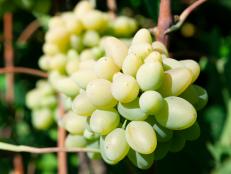Yes, You Can Grow Your Own Fruits and Veggies Indoors
Everything you need to know to start indoor hydroponic gardening today.
.jpeg.rend.hgtvcom.91.91.suffix/1699380946260.jpeg)

Imgorthand/Getty Images
The secret to having fresh fruits and vegetables at your fingertips all year long isn’t to buy acres of land and master agriscience, though that sounds impressive (and expensive). Indoor hydroponics, or growing plants in containers of nutrient-infused water rather than soil, lets home gardeners cultivate tomatoes, strawberries, lettuces and more in small spaces without so much as opening their front doors. It sounds and is scientific — but is also surprisingly easy once you get the hang of it.
It’s also increasingly popular. The global hydroponics market was valued at $2.58 billion in 2021 and is expected to hit $13.61 billion by 2030. Comparatively small ecological and economical footprints make hydroponic systems attractive to everyone from the U.S. Department of Agriculture and climate scientists to home cooks who’d simply love to crunch into a bowl of locally grown arugula in the dead of winter.
So, what is an indoor hydroponic system, exactly? And how do you set one up?
Indoor Hydroponics: What to Know
Indoor hydroponics is a way to grow plants without soil by either submerging their roots in a container of water mixed with nutrients or by suspending them in fibers over a similarly enriched reservoir.
“Hydroponics comes from the Greek word for hydro, which means water, and ponos, which means work. The water is doing the work, essentially,” explains Dave Harris the director of crop research and development at Freight Farms, a Boston-based company that specializes in container farming. “You take all the nutrients that plants would normally get from the soil, and you put them directly into the water that you feed the plants.”
Every plant needs a few things to grow: light, water, nutrients, the right temperature, space and time. "With hydroponics, you have to provide all those same inputs for plant growth in water and inside,” says Harris. Advocates believe that plants grow faster in hydroponic systems and, when monitored successfully, battle fewer pests and diseases than in many outdoor operations.
If the idea of soil-free gardening has you scratching your head, think back to 2020, when many Americans regrew scallions in jars of water during pandemic shutdowns. If you were among them, you might have noticed your scallions fared best when you kept them in the sun and frequently changed their water. They didn’t propagate new shoots, however, and probably withered after a week or so. That’s because those water-grown scallions lacked the nutrients that plants get from soil.
In a hydroponic system, you mix fertilizer or nutrients into the water so the plant has what it needs to survive. You also regularly refresh your plants’ water, either manually or with the sort of pump you’d find in a fish tank. Some indoor hydroponics gardeners also use a grow light to help the plant photosynthesize, or turn the carbon dioxide and water into food. These lights differ from traditional household lamps because they emit less heat and provide a broader spectrum of colors of light.
Grow lights are especially important for people with homes in colder climates that receive less sunlight, explains Char and Marv @plantedinthegarden, a social media account that focuses on cultivating plants in small spaces. “I’m from the Philippines, where we grow a lot of tropical plants,” he says. Now based in Toronto, he finds that “a good grow light system can make a big difference in what we’re able to grow.” He's used an indoor hydroponic system to cultivate leafy greens like bok choy, tatsoi and mizuna during frosty Canadian winters but says that everything from eggplants to tomatoes to peas are all within the realm of possibility.
Hydroponic Systems to Try
No two households are alike, so every indoor hydroponic system needs to be different. If you love a project and consider yourself handy, you can build your own. @plantedinthegarden has a visual guide in an Instagram post, or you can consult a trusted local hardware or gardening store. If you prefer a less DIY approach, companies like Spider Farmer, Aerogarden and Lettuce Grow sell packaged hydroponic kits with containers, nutrient or fertilizer mixes and other things you need to get started. Whichever route you choose, there are a few types of hydroponic systems to consider. Here are some of the more common varieties.
Indoor Gardens to Try
Wick System
The wick system involves connecting a reservoir of enriched water to a growing tray of seedlings via wicks, or nylon ropes. Arguably the most lo-fi way to set up hydroponics at home, a wick system is great for beginners and those looking to grow plants and herbs that don’t need a large amount of water, like arugula and rosemary. Plants grow more slowly via wick system than some other hydroponic approaches, however, and it’s not ideal for plants like tomatoes that require a lot of water.
Freight Farms uses a type of wick system to grow some 4,000 plants in a 325-foot space, Harris says. “It’s on a vertical plain, so we use space super efficiently.”
Ebb and Flow System
Also known as flood and drain, this system has a relatively straightforward process: you put your plants in containers on a shallow tray, and pump nutrient-rich water into that tray from a reservoir below. After the plants are hydrated, leftover water trickles back down to the reservoir to be reused.
To set this up at home, you’ll need what’s called a flood tray, or a relatively shallow tray, plus pots that are about twice its height filled with a soil additive like Perlite to help with aeration. Ebb and flow systems also require a water pump to distribute and recycle the water and a timer to keep everything running smoothly. Most growers consider this a somewhat intermediate system: it requires a bit of commitment to set up but is easy to maintain. It’s also a versatile system, equally suited to growing leafy greens and trickier fruits and vegetables like tomatoes and squash.
Nutrient Film Technique (NFT)
These popular systems are similar to ebb and flow set-ups. NFTs also pump enriched water from a reservoir to a growing vessel and then reuse the extra water, but they do so on a continuous loop with no off time and swap the flat flood tray for tubes or pipes. Homemade NFTs typically start with PVC or other inexpensive pipes with holes drilled into their sides to fit small pots filled with growing medium and seedlings.
Harris estimates that 50% or more of commercial hydroponic systems have an NFT component because “they’re very space efficient... It’s a great way to grow a lot of small plants.” You can grow all sorts of fast-growing plants in an NFT system, but they need to have relatively shallow root structures to be contained in those pots.
Deep Water Culture (DWC)
DWC systems suspend the roots of your plant in a relatively deep reservoir filled with a water-nutrient solution. They require less daily maintenance than ebb and flow systems but do need to be monitored to be sure the pH is balanced so your plants can get the nutrients they need. While NFTs are suited to plants with shallow roots, DWC systems are ideal for those that need a bit more vertical space to grow, like lettuces and herbs. And, because plants are continuously submerged in the DWC model, you’ll see very fast growth.

Calvin Chan Wai Meng/Getty Images
Expert Tips for First-Time Hydroponic Gardeners
Like traditional gardening, or any DIY project, there’s a learning curve to hydroponics. Your first plants might not grow immediately and flawlessly, but that doesn’t mean the second or third ones won’t. “There are going to be some technical issue you’re going to run to, but don’t give up,” Marv says.
Packaged kits tend to be easier to master than DIY systems, so if you’re cautious start with a readymade system and, once you’ve gotten the hang of it, consider building your own down the line.
Marv recalls how, the first time he tried to set up his own DIY hydroponic system, nothing grew. “I can’t even remember what plant it was, but it was tragic, that’s for sure.” He kept trying and has now advised several friends and acquaintances on their own hydroponic set-ups. “Nothing is going to be perfect the first time. Every year you learn.”
It’s excellent advice for gardening and for life.
Related Links:



























